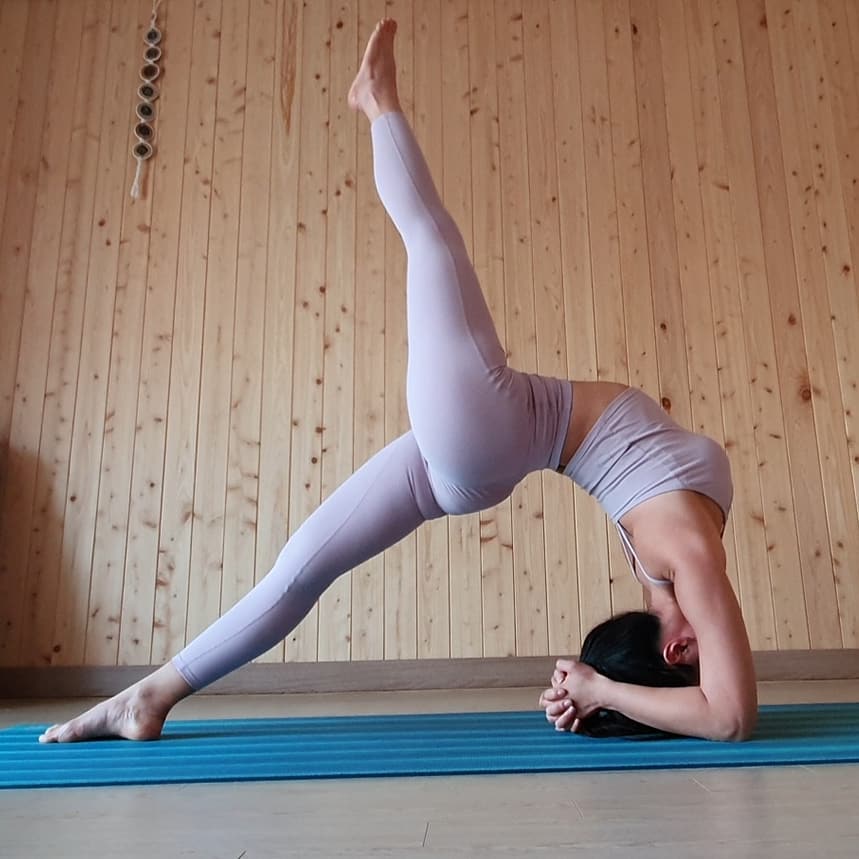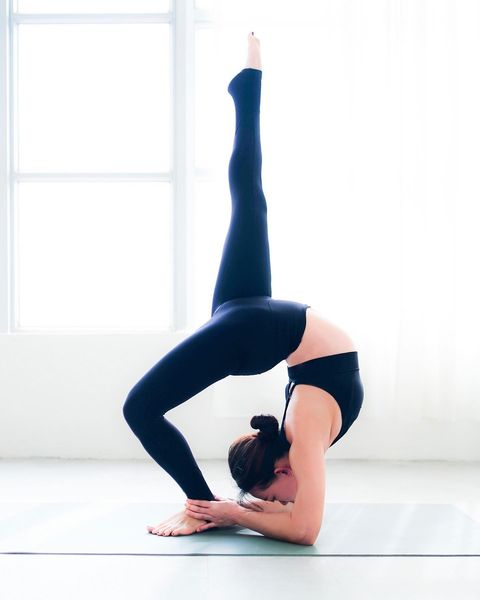Eka Pada Viparita Dandasana, also known as One Legged Inverted Staff Pose, stretches the entire front body and opens the chest. Strengthens core and balance.
Experts believe that the pose increases strength in the spine, hips, legs, abdomen, wrists and arms while expanding your lungs and chest. Eka Pada Viparita Dandasana can stimulate your pituitary and thyroid glands while increasing your energy. The pose is used therapeutically to treat asthma, back problems and infertility.
Information
| Known as: | Eka Pada Viparita Dandasana, One Legged Inverted Staff Pose, One Legged Reversed Staff Pose, Prapada Baddha Pada Eka Pada Viparita Dandasana, Eka Pada Viparita Dandasana II |
| Sanskrit name: | एक पाद विपरीत दण्डासन |
| IAST: | Eka Pāda Viparīta Daṇḍāsana |
| Pronunciation: | aa-KAH puh-duh vi-puh-REE-tuh duhn-DAHS-uh-nuh |
| Type: | Back-Bend, Inversion, Chest opener |
| Level: | Advanced |
| Total time: | 10 to 30 seconds |
| Drishti: | Third eye, between the eyebrows (Bhrumadhye or Ajna) |
| Chakra: | Sahasrara Chakra, Ajna Chakra, Vishuddha Chakra, Anahata Chakra, Manipura Chakra, Swadisthana Chakra |
| Focus: | Whole body |
| Indications: | Asthma, back problems, infertility; stimulate pituitary and thyroid |
| Preparatory poses: | Urdhva Dhanurasana, Sirsasana, Purvottanasana, Dwi Pada Viparita Dandasana |
| Follow-up poses: | Adho Mukha Svanasana, Uttanasana, Marichyasana-1 |
| Contraindications: | Headache, heart problems, high blood pressure or low blood pressure, carpal tunnel, diarrhea |
Meaning
The Eka Pada Viparita Dandasana is derived from the Sanskrit name, which is made up of five words — Eka + Pada + Viparita + Danda + Asana:
- “Eka” = “one”
- “Pada” = “leg or foot”
- “Viparita” = “inverted or reverse”
- “Danda” = “staff or stick”
- “Asana” = “pose or posture”
Benefits of Eka Pada Viparita Dandasana (One Legged Inverted Staff Pose)
The physical and mental benefits of Eka Pada Viparita Dandasana are listed below:
- Physical Benefits:
- Opens and stretches the chest area
- Improves the mobility of the spine
- Tones the back muscles
- Strengthens the shoulders, lower back, middle back, neck, biceps, triceps, psoas, quadriceps, legs and torso
- Helps to get rid of any excess fat around the belly
- Improves posture and flexible
- Improve the core stability
- Develops the sense of balance
- Improves the flow of blood
- Eliminate the harmful toxins from the body
- Helps to relieve constipation
- Helpful with a medical condition known as a prolapsed bladder or cystocele
- Reduces symptoms of menstruation and menopause
- Mental Benefits:
- Promotes acceptance, compassion, self-esteem, and boosts self-confidence
- Relieve stress
- Relieve depression
- Improves the mind and concentration
Pada Garudasana in Eka Pada Viparita Dandasana Practice Guide
Eka Pada Viparita Dandasana (One Legged Inverted Staff Pose) is one of the most advanced backbending poses and therefore requires extensive preparation.
There are several stories or foci of the pose, including an inversion, a backbend, and a split. The hip of the raised leg is flexed, and the knee is extended like in Hanumanasana (Monkey pose). The hips of the leg that remain on the floor are extended, the knee is initially flexed and then straightened to deepen the pose, as in Urdhva Dhanurasana (Upward bow or wheel pose). Then there is the balance component, in which the forearm and standing leg from a tripod to support the inverted torso. Accordingly, one must be able to invert, backbend and split in order to perform One Legged Inverted Staff Pose.
Each component of this yoga pose can be broken down into smaller parts that contribute to the whole. Preparation and training should focus on smooth stretching of the hip flexors, hip extensors and hamstrings, as explained in the article on Monkey Pose. You can also apply several preparatory stretches to gain mobility in the shoulders.
The grip on the ankle acts as a stabilizer, and the elbow serves as a base for opening the upper back. The leg on the floor can be extended at the knee to indirectly raise the pelvis and deepen the backbend. The leg in the air relies primarily on the strength of the hip and knee extensors to straighten, as well as on the length of the opposing muscles on the back of the leg to allow this movement. If you’ve built enough length into your hamstrings and gluteals, you can flex the hip and extend the knee with much less effort than if these muscles were tight.
Step-by-step instructions to Eka Pada Viparita Dandasana (One Legged Inverted Staff Pose) I

Instructions
- Do Dwi Pada Viparita Dandasana (Forearm Wheel Pose).
- Exhale and raise your left leg straight up while keeping your right leg on the floor in Viparita Dandasana.
- Stay in this posture for 10 seconds with normal breathing.
- Lower your left leg and come into the Viparita Dandasana (Inverted Staff Pose). Then exhale, keeping your right leg straight, repeat the pose for the same duration.
- Come back to the Viparita Dandasana and then rest on the floor.
- Advanced students can, on an exhalation, swing both legs up to Salamba Sirsasana (Headstand) I, then lower them to the floor and relax or do Urdhva Dhanurasana (Upward Facing Bow/Wheel Pose) and stand in Tadasana (Mountain Pose) or move into Viparita Chakrasana (Reversed Wheel Pose).
Step-by-step instructions to Eka Pada Viparita Dandasana (One Legged Inverted Staff Pose) II

Instructions
- Do Dwi Pada Viparita Dandasana (Forearm Wheel Pose).
- Take both the feet towards your head.
- Release your fingers, spread your wrists and rest your palms on the ground.
- While exhaling, lift your head off the ground, extend your neck towards your feet and bring your right leg near the hands.
- Grab your right ankle with both hands and rest your entire foot on the ground.
- When your grip on the ankles is strong, exhale and lift your left leg up by lifting your shoulders and extending your spine. Keep your leg taut at your knee.
- Stay in this posture for 10-15 seconds. Due to the contraction of your abdominal muscles, breathing will be fast and laborious.
- Bring your left foot down to the ground.
- Release your right ankle and grab your left. Repeat the pose described above, now raising your right leg vertically. Stay in the pose on the other side for the same duration. Then lower your raised leg.
- Release your ankle and on the exhalation, lower both the legs to Salamba Sirsasana (Headstand) I, then lower them to the floor and relax or do Upward-Facing Bow or Upward-Facing Wheel Pose and stand in Tadasana (Mountain Pose) or move to Viparita Chakrasana.
Step-by-step Anatomy Engaging Techniques
Step-1
- Stretch your back along your erector spinae and quadratus lumborum, and gently lift your head toward your leg.
- Draw your torso toward your foot by activating your anterior deltoids.
- Your back muscles work in sync with your anterior deltoids, levator scapula, and upper trapezius to deepen the pose.
- Contract your biceps and brachialis to bend your elbows.
- Notice how it draws you closer to your feet, opening your chest.
- Maintain your chest position, and then contract your triceps to press your forearms into the mat, bringing your upper arm bones perpendicular to the ground.
Step-2
Activate your quadriceps to partially extend your knee and lift your pelvis higher. Because your foot is resting on the mat and cannot kick out, the force of contracting your quadriceps lifts your pelvis. The adductor magnus draws your knee toward the midline and helps to extend your hip.
Step-3
To externally rotate your scapula, engage your serratus anterior and trapezius. Roll your shoulders outward by contracting your infraspinatus and teres minor muscles, and tilt the head back from your cervical spine.
Step-4
Flex your hip of the raised leg by engaging your psoas and its synergists, the pectineus, adductor longus and brevis, and sartorius. Contract your quadriceps to extend your knee. Your rectus femoris assists your psoas in crossing both your hip and knee due to its polyarticular nature.
Step-5
- Press your ball of the stand-leg foot into the mat by engaging your peroneus longus and brevis muscles on the side of your lower leg.
- Then distribute your weight toward your outer edge of the foot by activating your tibialis posterior.
- This combined inversion and eversion of your ankle joint helps to stabilize the foundation.
- Tilt the outer side of your raised leg down by connecting your peroneus longus and brevis. This extends your ball of the foot upward.
- Extend your toes toward the head by activating your long and short toe extensors. These actions on your foot of the upper leg open the sole, illuminating the small chakra located in this area.
Precautions and Contraindications
You must be careful while practicing Eka Pada Viparita Dandasana to avoid injuries. Considering that this is an advanced level asana, the following precautions and contraindications should be taken:
- Individuals with low or high blood pressure problems, neck, shoulder, arm, hip, back injuries, carpal tunnel, diarrhea, headaches or heart problems should avoid this pose or seek advice from an experienced yoga teacher/instructor before performing Eka Pada Viparita Dandasana or Prapada Baddha Pada Eka Pada Viparita Dandasana.
- Depression and symptoms related to depression, because blood flow to the heart and head is not safe.
- Surgery of any internal part of the body should be avoided. But it is important to take proper guidance from a yoga teacher/instructor.
- Pregnant women are advice to avoid practicing this yoga pose, it’s an advanced stage.















